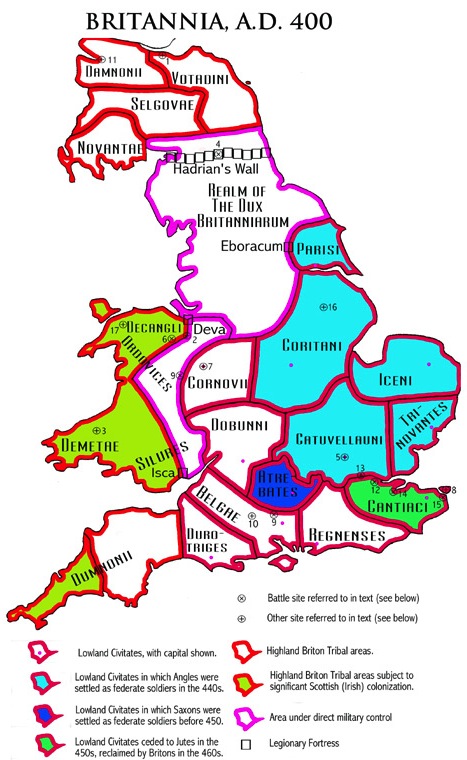
Places of Significance, 400-473 A.D.
1.
Dunedin (Edinburgh), centre of Manaw Gododdin, whence Cunedda came,
c.401.
2.
River Dee, boundary of Cunedda's descendants' territory
3.
River Teifi, boundary of Cunedda's descendants' territory
4.
Hadrian's wall, breached by Picts and Scots in the 410s.
5.
Verulamium (St. Alban's), where St. Germanus was resting when brought
news
of an attack by Saxons and Picts, c.429.
6.
Clwyd range near Mold, traditional site of St. Germanus' victory over the
Saxons and Picts.
7.
Viroconium, a town which, like Verulamium, certainly survived the Roman
withdrawal.
8.
Isle of Thanet, the first land ceded to Hengist and Horsa, c.450.
9.
Two possible sites for Wallop, the scene of a battle between Ambrosius
and Vitalinus c.453, one in Hampshire and the other in Shropshire
10.
Ambrosius' fort (Amesbury), Wiltshire, not far from Wallop in
Hampshire.
11.
Al Clud (Dumbarton), stronghold of Coroticus, berated by St. Patrick
for
taking fellow-Christians as slaves from Ireland.
12.
Crayford, on the confluence of the Cray and the Derwent, where Vortimer
was defeated by Hengist and Horsa, c.456.
13.
London, where Vortimer fled following this defeat.
14.
Aylesford, where Vortimer and Hengist fought again, and Categirn and
Horsa
fell, c.457.
15.
Richborough, probable location of the third battle between Vortimer and
Hengist, where Vortimer was victorious, c.461.
16.
Lincoln, where Vortimer was buried, c.470.
17.
Dinas Emrys (the stronghold of Ambrosius), near Snowden, supposedly
built
by Vortigern when he fled following the Saxon revolt, c.472.
